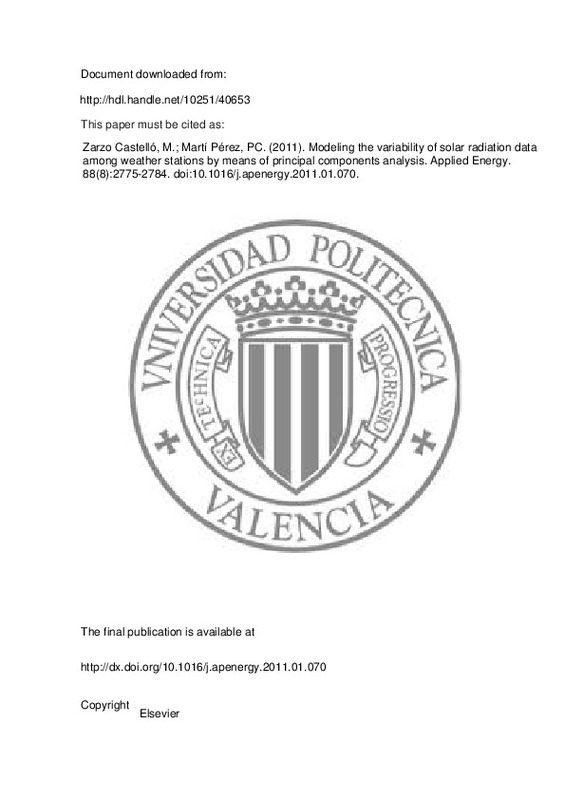JavaScript is disabled for your browser. Some features of this site may not work without it.
Buscar en RiuNet
Listar
Mi cuenta
Estadísticas
Ayuda RiuNet
Admin. UPV
Modeling the variability of solar radiation data among weather stations by means of principal components analysis
Mostrar el registro sencillo del ítem
Ficheros en el ítem
| dc.contributor.author | Zarzo Castelló, Manuel
|
es_ES |
| dc.contributor.author | Martí Pérez, Pau Carles
|
es_ES |
| dc.date.accessioned | 2014-10-06T07:41:23Z | |
| dc.date.available | 2014-10-06T07:41:23Z | |
| dc.date.issued | 2011-08 | |
| dc.identifier.issn | 0306-2619 | |
| dc.identifier.uri | http://hdl.handle.net/10251/40653 | |
| dc.description.abstract | Measurements of global terrestrial solar radiation (R s) are commonly recorded in meteorological stations. Daily variability of R s has to be taken into account for the design of photovoltaic systems and energy efficient buildings. Principal components analysis (PCA) was applied to R s data recorded at 30 stations in the Mediterranean coast of Spain. Due to equipment failures and site operation problems, time series of R s often present data gaps or discontinuities. The PCA approach copes with this problem and allows estimation of present and past values by taking advantage of R s records from nearby stations. The gap infilling performance of this methodology is compared with neural networks and alternative conventional approaches. Four principal components explain 66% of the data variability with respect to the average trajectory (97% if non-centered values are considered). A new method based on principal components regression was also developed for R s estimation if previous measurements are not available. By means of multiple linear regression, it was found that the latent variables associated to the four relevant principal components can be fitted according to the latitude, longitude and altitude of the station where data were recorded from. Additional geographical or climatic variables did not increase the predictive goodness-of-fit. The resulting models allow the estimation of daily R s values at any location in the area under study and present higher accuracy than artificial neural networks and some conventional approaches considered. The proposed methodology for estimating R s based on geographical parameters would be of interest to design solar energy systems and to select their best location. © 2011 Elsevier Ltd. | es_ES |
| dc.language | Inglés | es_ES |
| dc.publisher | Elsevier | es_ES |
| dc.relation.ispartof | Applied Energy | es_ES |
| dc.rights | Reserva de todos los derechos | es_ES |
| dc.subject | Missing data estimation | es_ES |
| dc.subject | Multivariate statistical monitoring | es_ES |
| dc.subject | PCA | es_ES |
| dc.subject | Solar radiation | es_ES |
| dc.subject.classification | ESTADISTICA E INVESTIGACION OPERATIVA | es_ES |
| dc.title | Modeling the variability of solar radiation data among weather stations by means of principal components analysis | es_ES |
| dc.type | Artículo | es_ES |
| dc.identifier.doi | 10.1016/j.apenergy.2011.01.070 | |
| dc.rights.accessRights | Abierto | es_ES |
| dc.contributor.affiliation | Universitat Politècnica de València. Departamento de Estadística e Investigación Operativa Aplicadas y Calidad - Departament d'Estadística i Investigació Operativa Aplicades i Qualitat | es_ES |
| dc.description.bibliographicCitation | Zarzo Castelló, M.; Martí Pérez, PC. (2011). Modeling the variability of solar radiation data among weather stations by means of principal components analysis. Applied Energy. 88(8):2775-2784. doi:10.1016/j.apenergy.2011.01.070 | es_ES |
| dc.description.accrualMethod | S | es_ES |
| dc.relation.publisherversion | http://dx.doi.org/10.1016/j.apenergy.2011.01.070 | es_ES |
| dc.description.upvformatpinicio | 2775 | es_ES |
| dc.description.upvformatpfin | 2784 | es_ES |
| dc.type.version | info:eu-repo/semantics/publishedVersion | es_ES |
| dc.description.volume | 88 | es_ES |
| dc.description.issue | 8 | es_ES |
| dc.relation.senia | 41297 |







![[Cerrado]](/themes/UPV/images/candado.png)

